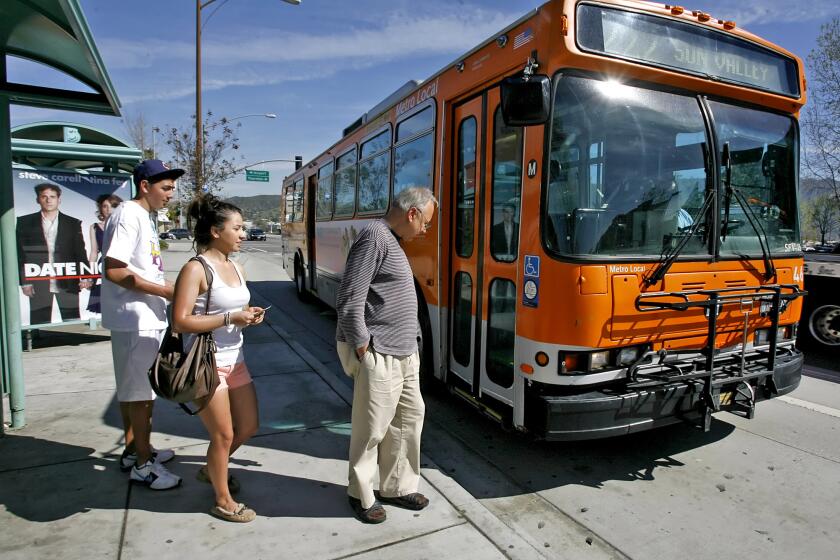Ill Wind for Gliders : Project Casts Shadow Over Plane Buffs’ Hilltop in Thousand Oaks
Taking off with a wobble that would give an air traffic controller heartburn, the blue-and-white plane zigged, zagged and tilted alarmingly before swooping down to ride an invisible current.
Sonny Kim watched with satisfaction, controlling the lightweight model airplane with the tip of one finger by maneuvering a miniature joystick on his radio transmitter.
Along with half a dozen other members of the Thousand Oaks Soaring Society, better known as TOSS, Kim has spent hundreds of hours flying silent, radio-controlled gliders off a grassy plateau south of Hillcrest Drive and east of Erbes Road.
But the fate of this launch pad, aptly dubbed Glider Hill, is now up in the air.
For almost two decades, the hill’s owner has allowed model airplane buffs from miles around to fly their gliders on his property. But a developer recently received city Planning Commission approval to build 10 homes on the east side of the hill--and future residents might well decide to boot the fliers out by hanging “No Trespassing” signs.
Developer Paul Bollinger has promised to preserve 11 acres of the arid hilltop, including the gliders’ plateau, as a recreation area, complete with trails for hikers, bikers and equestrians.
But when he tried this week to turn the parcel over to the Conejo Open Space Conservation Agency, which owns more than 10,000 acres of parkland in Thousand Oaks, the board of directors rejected his gift.
Citing concerns about possible landslides and costly maintenance, the conservation agency refused to accept responsibility for the steep hill, which is not contiguous to other parkland and is almost impossible for a ranger vehicle to reach. The agency deferred a final decision on the property until September.
Unless the agency’s directors reconsider, or the city steps in to accept the parcel, Glider Hill will remain in private hands. And future homeowners will decide whether to allow the fliers to launch model airplanes from their communal back yard.
Developer Bollinger could not be reached for comment Thursday. But the remote-control pilots who have used Glider Hill for almost two decades were crushed at the prospect of being kicked off the property, which they said has the best wind currents and landing space for miles around.
“It looks to me like we’re going to lose it,” Edgar Weisman said sadly.
Like most glider buffs, Weisman began flying model planes as a boy--in his case, back in 1936, “when we didn’t have any radios or TVs and people were very excited about airplanes,” he said.
The 62-year-old Weisman started with simple toss-and-chase models, throwing them off a hilltop, watching them crash below, and scurrying to retrieve them. “I guess I never grew out of them,” he said.
Now he designs and builds his gliders, at a cost of anywhere from a few hundred dollars to $1,000. With his buddies, Weisman spends his weekend afternoons basking in the sun on Glider Hill, guiding his models into air currents and keeping them aloft for hours on end.
“I don’t know what a young man does with himself in town these days unless he gets involved in a hobby like this,” said Weisman, who teaches a class on building and piloting gliders every year.
Some airplane enthusiasts fly loud, motor-powered crafts off the hill, but true gliders are silent. Made from balsa wood and rubber bands, with wingspans ranging from 8 to 15 feet, the gliders move at the whims of their distant pilots, who use remote-control radios to manipulate the planes’ rudders.
Now circling lazily overhead, now dipping abruptly with a rush of speed, the brightly colored gliders shimmer in the sun and land with a whispery rustle in the knee-high grass. Occasionally, they crash into a nearby back yard, or come to roost in a tall tree, but usually they return to within a few feet of their owner.
Controlling the planes takes practice--and considerable skill--because pilots must guide their craft into ever-shifting wind currents. Some stunt fliers make their gliders roll over or arc in loops. But most prefer just to tune out the world and relax.
“Everyone’s competitive in the rat race in the real world, but this is a chance to blow it all off,” said Lex Mierop, 29.
As he guided his red-and-white craft in for a landing, retiree Keith Jones admitted to spending at least three hours a day on Glider Hill. “I forget any troubles I might have when I’m up here,” he said. “It’s such a nice escape.”
Sign up for The Wild
We’ll help you find the best places to hike, bike and run, as well as the perfect silent spots for meditation and yoga.
You may occasionally receive promotional content from the Los Angeles Times.



